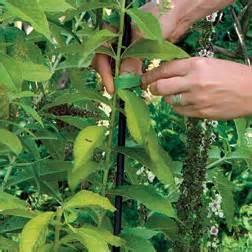Unused stories
Gardening Tips - Staking your plants
Don’t Let Those Precious Perennials Flop!

Metal grids are excellent choices for large, floppy plants. The three-inch mesh grids in a circular frame are available in several sizes. Grids, also known as heads, should be installed early in the growing season when plants are just a few inches tall. The grid is nearly invisible by the time the plant is fully leafed out. The grid and legs are often sold separately. You will need three legs to support each head. They are made of plastic-coated steel and last for many years.
Linking stakes are L-shaped with a loop at the top of the upright and a hook at the end of the arm. These hook together to make irregularly shaped configurations by inserting the hook of one into the loop of an adjacent stake. Linking stakes are used when plants are already past the point of using other staking methods. When installing the linking stakes, use enough of them to prevent the plant from looking like it was crammed into a cage.
Chicken wire is an excellent staking tool for the garden. It works well for thin-stemmed plants, such as asters, whose foliage is not dense enough to hide a metal grid. When the plant is young, encircle it with a cylinder of chicken wire. It should be slightly narrower than the plant's mature width and lower than its full grown height. Stabilize the wire by weaving two or three bamboo stakes through the openings and securing them in the ground. New growth will thread its way through the mesh and cover the wire. Plants retain their natural profile without flopping on their neighbors.
Single stakes are best for mature plants. They are also useful for supporting lilies, delphiniums, and other vertical plants with few side branches. Stakes made of plastic or plastic-coated steel are available in various heights and colors. They often look like simulated bamboo with raised horizontal rings or with small projections along the stake. These projections prevent the twine from slipping. Stake single stems when the plant has almost attained its full height but before the flower buds open. At this time, stems have taken on their natural angle which should remain even after staking. If plants are in a windy location, stake earlier in the growing season. When driving the stake into the ground, be careful not to damage bulbs. Allow enough room between the stake and the root system. Materials used for tying should be soft and flexible. Do not tie the stems too close and tight or the stem will be damaged. If it is not tied tight enough, the stem will fall out of line. Make a twist in the twine between the plant and the stake so the stem does not come in direct contact with the stake. When working with extremely tall stems, tie the plant to the stake in more than one place. The uppermost tie should be well below the flowers.
Proper staking requires time, patience, and practice. Early efforts often result in a stiff military or a crammed appearance. With practice, a desirable final product emerges. Staking allows the natural form of the plant to come through without showing everyone its hidden flaws.
By S. Rindels, Department of Horticulture, Iowa State University Extension;
Edited for the Marin Master Gardener website by N. Londeree
